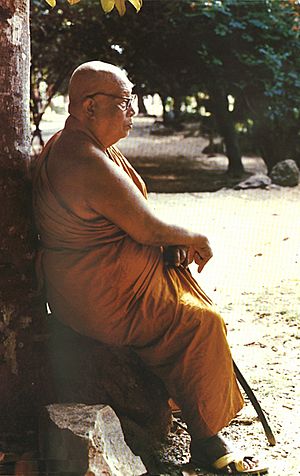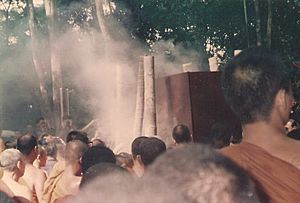Buddhadasa facts for kids
Quick facts for kids Phra Dharmakosācārya(Nguam Indapañño) "Buddhadāsa Bhikkhu" |
|
|---|---|
| Nguam Panitch | |
 |
|
| Religion | Buddhism |
| School | Theravada, Maha Nikaya |
| Other names | Buddhadāsa |
| Dharma names | Indapañño |
| Personal | |
| Nationality | Thai |
| Born | May 27, 1906 Phumriang, Chaiya, Chaiya (now Surat Thani), Thailand |
| Died | May 25, 1993 (aged 86) Wat Thannamlai, Chaiya, Surat Thani, Thailand |
| Senior posting | |
| Title | Phra Khru Indapaññacariya (1946) Phra Ariyanandamuni (1950) Phra Rajajayakavi (1957) Phra Debvisuddhimedhi (1971) Phra Dharmakosacarya (1987) |
Phra Dharmakosācārya (Nguam Indapañño) (Thai: พระธรรมโกศาจารย์ (เงื่อม อินฺทปญฺโญ)), also known as Buddhadāsa Bhikkhu (Thai: พุทธทาสภิกขุ), was a very important and wise Buddhist teacher from Thailand. He lived from May 27, 1906, to May 25, 1993.
Buddhadāsa Bhikkhu was known for his fresh ideas about Buddhism. He helped people in Thailand and around the world understand Buddhist teachings in new ways. He believed that deep down, all religions share similar important truths. He even said that if you truly understand dhamma (the teachings of truth), you might feel there is no need for separate religions.
Contents
Who was Buddhadāsa Bhikkhu?
His Early Life
Buddhadāsa Bhikkhu was born in 1906. His birth name was Nguam Phanit (Thai: เงื่อม พานิช). He grew up in a place called Ban Phumriang in southern Thailand. His father, Sieng Phānit, was a shopkeeper with Chinese family roots. His mother, Klaun, was Thai.
Becoming a Monk
In 1926, Nguam decided to become a monk. This meant he left his normal life behind. Like many young monks, he went to Bangkok, the capital city, to study Buddhist teachings.
However, he found the temples there to be crowded and not very clean. He also felt that many monks were too focused on fame and comfort. They seemed less interested in the true, high ideals of Buddhism.
Because of this, he went back to his quiet hometown. In 1932, he started his own forest retreat called Suan Mokkh. This name means "Garden of Liberation" in Thai. It was a place where he could focus on deep study and practice.
His Later Years and Teachings
As years passed, Buddhadāsa's teachings became very popular. Many people from different countries came to his peaceful retreat to learn from him. He also had important discussions with leaders and scholars from various religions. He wanted to find the common truths that connect all major world religions.
Before he passed away in 1993, he created an International Dhamma Hermitage Center. This center was built across the road from his own retreat. Its purpose was to help international students learn about Buddhism and other spiritual practices. The area of Suan Mokkh grew to be about 120 acres of forest.
Even with his fame, Buddhadāsa remained humble. He sometimes joked that many visitors to Suan Mokkh might just be stopping by to use the bathroom!
How Buddhadāsa Influenced Others
Buddhadāsa's fresh ideas about Buddhism inspired many important people. One example is Pridi Banomyong, a leader of the 1932 Siamese revolution in Thailand. Buddhadāsa also influenced many Thai social activists and artists in the 20th century.
Some religious experts have compared Buddhadāsa to ancient Buddhist thinkers like Nagarjuna. They say his ideas were very different from some traditional Buddhist scholars. Buddhadāsa's writings, for instance, were quite different from the well-known Visuddhimagga by Buddhaghosa.
Buddhadāsa was also important in the "forest tradition" of Thai Buddhism. His ideas even influenced a newer Buddhist movement called Santi Asoke. Scholars like Peter Jackson and Daniel Lynch believe Buddhadāsa was also inspired by Zen Buddhism. He saw Zen ideas as a way to connect traditional Buddhism with modern thinking. He thought this was why Japan became so strong economically.
What Books Did He Write?
Buddhadāsa wrote many books. His works fill an entire room in the National Library of Thailand. Some of his well-known books have been translated into English, such as:
See also
 In Spanish: Buddhadasa para niños
In Spanish: Buddhadasa para niños



